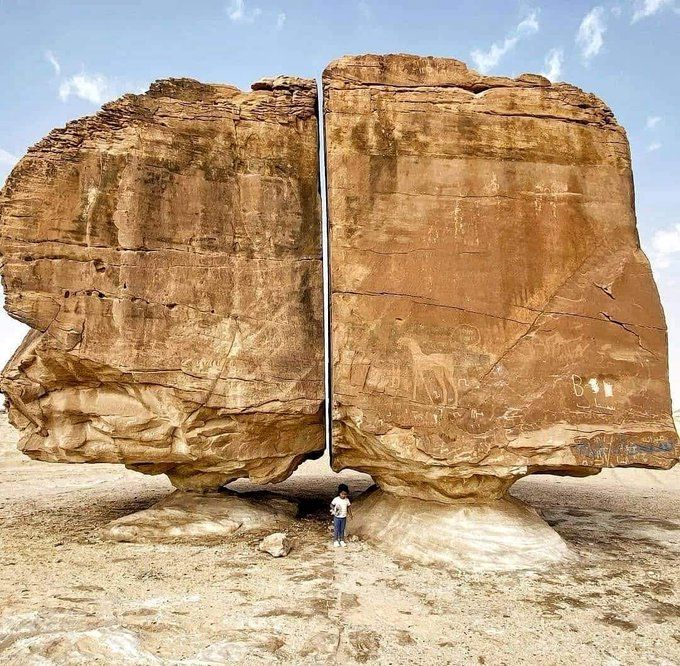The Al Naslaa Rock Formation is a giant stone in the Saudi Arabian desert that looks like it was cut perfectly in half by a high-powered laser — almost like something out of a science fiction movie. While the idea of aliens slicing it is entertaining, scientists believe the rock split naturally, shaped entirely by Earth’s forces.

What makes it even more stunning is that each half of the 6-meter (20-foot) high boulder rests on its own narrow base, giving the illusion they are floating in balance, barely touching. The precision of the split seems too perfect to be accidental, but most experts credit natural weathering for this extraordinary formation.
The Ancient Carvings on Al Naslaa
Located in Tayma Oasis, the rock also features petroglyphs — images carved directly into the surface. These carvings show humans, Arabian horses, and ibexes, and while the exact age of the artwork is uncertain, the rock itself has stood for thousands of years.

What Could Have Split the Rock?
Several theories attempt to explain the mysterious split:
-
Tectonic Shift Theory: One idea is that the rock lies along a fault line. A shift in the Earth beneath it could have caused it to crack at a weak point. Wind and sand might have later polished the fracture, turning it into the razor-sharp divide we see today.
-
Wind and Sand Erosion: Once the crack formed, strong desert winds blowing fine grains of sand through the gap could have slowly smoothed the edges, sharpening the divide over millions of years.
-
Geological Joint: Another possibility is that it’s a joint — a natural break in rock with no movement on either side. It just happens to be unusually straight and even, making it look artificial.
-
Freeze-Thaw Cycle: During ancient times, water might have entered a small crack, frozen, and expanded. This process, repeated over time, could have split the rock further until it completely separated into two.
The Mysterious Pedestals
The bases under each rock half are known as mushroom rocks — common in deserts. These form when wind erosion wears away the lower parts faster than the top, or when glacial movement pushes rocks into their current positions.
The Al Naslaa rock formation, found in Saudi Arabia, is one of Earth’s greatest mysteries. Two boulders, six meters (20 feet) high, stand atop their own pedestals, separated by a perfectly smooth crack. #ngss #ngsschat #nsta pic.twitter.com/UVXcWxyYGE
— Phenomena (@NGSSphenomena) March 22, 2022
Did Humans Split the Rock?
Because sandstone is relatively soft, it’s possible ancient people could have carved it using simple tools. But why would they go to the trouble? Some believe it may have had spiritual meaning, been a territorial marker, or simply an early expression of art. The petroglyphs support the idea that humans were drawn to this place long ago.
Want to See It for Yourself?
If you’re intrigued, you can visit the Al Naslaa Rock Formation in Tayma Oasis, not far from the Al Knanafah Wildlife Sanctuary in Saudi Arabia. Whether shaped by nature or something else, it remains one of Earth’s most mysterious and visually striking rock formations.


